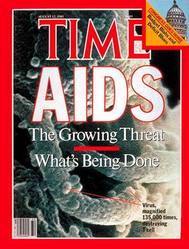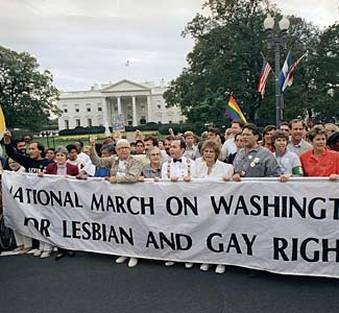The Darker Side of the '80s
It began in 1981, when Los Angeles and New York City reported mysterious cases of rare forms of cancer and pneumonia in young, healthy men due to a severely compromised immune system. Their only similarity? They were all gay.
By 1982, the disease was going by several different names, among them "GRID" (gay-related immune deficiency) and "gay cancer." However, by June, a small number of the 355 reported cases were heterosexual men and women, many of them intravenous drug users. The term AIDS (acquired immune deficiency syndrome) was first used by the CDC in September of 1982, when they estimated that 1 to 2 cases of AIDS were being diagnosed each day (29).
The results of the rapid spread of the disease were both panic and stigma. The press created a panic through fear-mongering at the expense of facts, and many public officials lacked the courage to correct them. Coverage such as Life Magazine's 1985 "NOW NO ONE IS SAFE FROM AIDS" cover and Time Magazine's 1985 "AIDS The Growing Threat" cover spread panic like wildfire. It was a vicious cycle, panic led to ridiculous rumors, such as the fact that AIDS could be spread from kissing, or toilet seats, and these rumors only increased panic (30).
A huge stigma surrounded the disease because of both a lack of knowledge and the associations of the disease. Because AIDS was associated with gays and intravenous drug users, both groups already being discriminated against, victims of AIDS inevitably received discrimination. Even some doctors were reluctant to investigate further, simply because of the stigma surrounding the disease. Dr. Joel Weisman even said regarding the attitude of one of his colleagues, ""I remember calling a person [in infectious diseases] to describe what was occurring. He said - and this was a theme very early on - 'I don't know what you're making such a big deal of it for. If it kills a few of them off, it will make society a better place'" (29).
A juxtaposition in the AIDS epidemic existed between what the public believed and what the reality actually was. Because of fear-mongering and panic, the epidemic was blown completely out of proportion. Take New York City for example; in 1988, it was estimated that 400,000 New Yorkers carried the AIDS virus, until the city health commissioner corrected the number in July to 200,000. In fact, the number was probably half that (30). Panic created a startling difference between what people thought and what was the truth, between the actual epidemic, which was frightening enough in and of itself, and the panicky, blown-out-of-proportion epidemic that existed in the press and in people's minds.
By 1982, the disease was going by several different names, among them "GRID" (gay-related immune deficiency) and "gay cancer." However, by June, a small number of the 355 reported cases were heterosexual men and women, many of them intravenous drug users. The term AIDS (acquired immune deficiency syndrome) was first used by the CDC in September of 1982, when they estimated that 1 to 2 cases of AIDS were being diagnosed each day (29).
The results of the rapid spread of the disease were both panic and stigma. The press created a panic through fear-mongering at the expense of facts, and many public officials lacked the courage to correct them. Coverage such as Life Magazine's 1985 "NOW NO ONE IS SAFE FROM AIDS" cover and Time Magazine's 1985 "AIDS The Growing Threat" cover spread panic like wildfire. It was a vicious cycle, panic led to ridiculous rumors, such as the fact that AIDS could be spread from kissing, or toilet seats, and these rumors only increased panic (30).
A huge stigma surrounded the disease because of both a lack of knowledge and the associations of the disease. Because AIDS was associated with gays and intravenous drug users, both groups already being discriminated against, victims of AIDS inevitably received discrimination. Even some doctors were reluctant to investigate further, simply because of the stigma surrounding the disease. Dr. Joel Weisman even said regarding the attitude of one of his colleagues, ""I remember calling a person [in infectious diseases] to describe what was occurring. He said - and this was a theme very early on - 'I don't know what you're making such a big deal of it for. If it kills a few of them off, it will make society a better place'" (29).
A juxtaposition in the AIDS epidemic existed between what the public believed and what the reality actually was. Because of fear-mongering and panic, the epidemic was blown completely out of proportion. Take New York City for example; in 1988, it was estimated that 400,000 New Yorkers carried the AIDS virus, until the city health commissioner corrected the number in July to 200,000. In fact, the number was probably half that (30). Panic created a startling difference between what people thought and what was the truth, between the actual epidemic, which was frightening enough in and of itself, and the panicky, blown-out-of-proportion epidemic that existed in the press and in people's minds.
A Timeline of Homosexuality and AIDS in the '80s
1980
-The Democratic National Convention supports gay rights (12).
1981
-The first cases of Kaposi's Sarcoma and Pneumocystis carinii pneumonia are reported in young gay men in California and New York (13).
-The World Health Organization removes homosexuality from its list of mental illnesses (27).
1982
-By the beginning of July, 452 cases of the virus are reported to the CDC (13).
-The virus is named Acquired Immune Deficiency Syndrome (AIDS) (13).
-The Department of Defense issues a policy stating the incompatibility between homosexuality and military service (27).
1983
-Reports of AIDS among women suggest the possibility of transmission of the virus through heterosexual sex (13).
-Talk begins of the "4-H" club of those at risk for AIDS: homosexuals, haemophiliacs, heroin addicts, and Haitians (13).
-By the end of 1983, there are 3,064 reported cases of AIDS in the U.S. and 1,292 had died (13).
-Massachusetts Representative Gerry Studds becomes the first openly gay member in Congress (27).
1984
-The HIV Virus is identified as a probable cause of AIDS (27).
-Numbers continue to rise-by the end of the year the number of reported cases in the U.S. rises to 7,699 and the number of deaths is at 3,665 (13).
1985
-Hollywood releases "Kiss of the Spider Woman." The movie is one of the first to portray gay men in a positive manner (27).
-A rumor begins that AIDS can be transmitted through drinking communion wine (13).
-The CDC removes Haitians from its list of groups at risk for AIDS (13).
-President Reagan publicly mentions AIDS for the first time (13).
-Actor Rock Hudson becomes the first major public figure to die from AIDS (27).
1986
-President Reagan calls for a reduction in spending on AIDS research (27).
-A drug called azidothymidine (AZT) is discovered that slows down the progression of HIV (13).
1987
-Between 200 and 500 thousand gays and lesbians participate in the National March on Washington for Lesbian and Gay Rights (27).
1988
-Baltimore passes a civil rights bill prohibiting discrimination against gays and lesbians (27).
1989
-Massachusetts passes a bill protecting gays and lesbians from discrimination (27).
-The District of Columbia passes a hate crimes bill, increasing the penalties for crimes motivated by homophobia (27).


